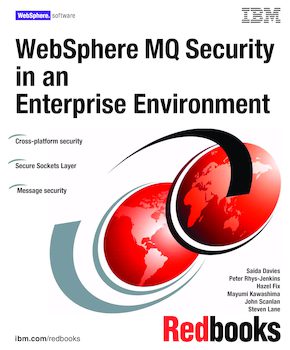WebSphere MQ Security in an Enterprise Environment
An IBM Redbooks publication
Note: This is publication is now archived. For reference only.

Published on 07 May 2003, updated 09 May 2003
ISBN-10: 0738425621
ISBN-13: 9780738425627
IBM Form #: SG24-6814-00
Authors: Saida Davies, Peter Rhys-Jenkins, Hazel Fix, Mayumi Kawashima, John Scanlan and Steven Lane
This IBM Redbooks publication considers an enterprise and describes some of the procedures and documentation that need to be developed to secure WebSphere MQ on the z/OS (zSeries), OS/400 (iSeries), IBM AIX (pSeries) and Windows 2000 (xSeries) platforms. This book also documents the before and after configurations needed to take advantage of the recent functional improvements to WebSphere MQ, such as the Secure Sockets Layer (SSL).
Security is a complex subject. The first part of this book is intended to help the reader understand it. The second part lays out a business case scenario where the technology is implemented to secure WebSphere MQ.
The book incorporates:
- Cross-platform security, ascertaining the responsibility of identification and authentication.
- Security issues when using WebSphere MQ over the Internet.
- Securing of messages, taking advantage of the functional improvements to WebSphere MQ such as PKI and SSL.
- Maintenance of message integrity by means of authentication and encryption.
- Use of technologies external to WebSphere MQ, such as PKI, DCE, and RACF to solve the security concerns.
The appendixes provide additional information, scripts, sample code and JCL related to the chapters in the book.
Part 1. Enterprise security
Chapter 1. Project overview
Chapter 2. Planning
Chapter 3. Security technologies
Chapter 4. Platform security
Chapter 5. IBM Tivoli Access Manager for Business Integration
Part 2. Securing WebSphere MQ
Chapter 6. Management issues
Chapter 7. Business scenario
Chapter 8. Business scenario architecture
Chapter 9. Business scenario security configuration
Chapter 10. Architectural vulnerabilities
Chapter 11. Business scenario solution
Appendix A. Good security practices
Appendix B. Scripts, samples code and JCL
Appendix C. Additional information